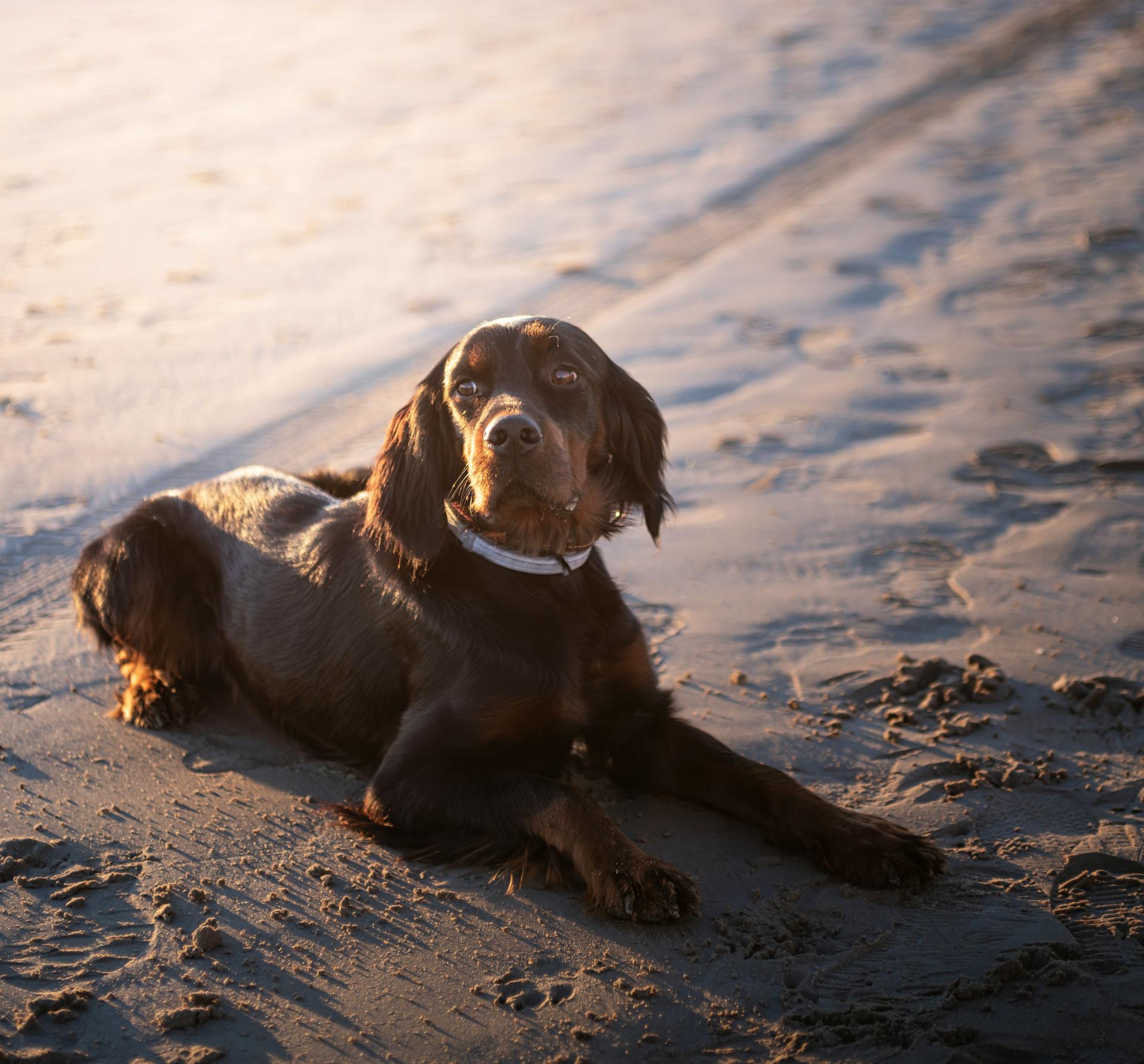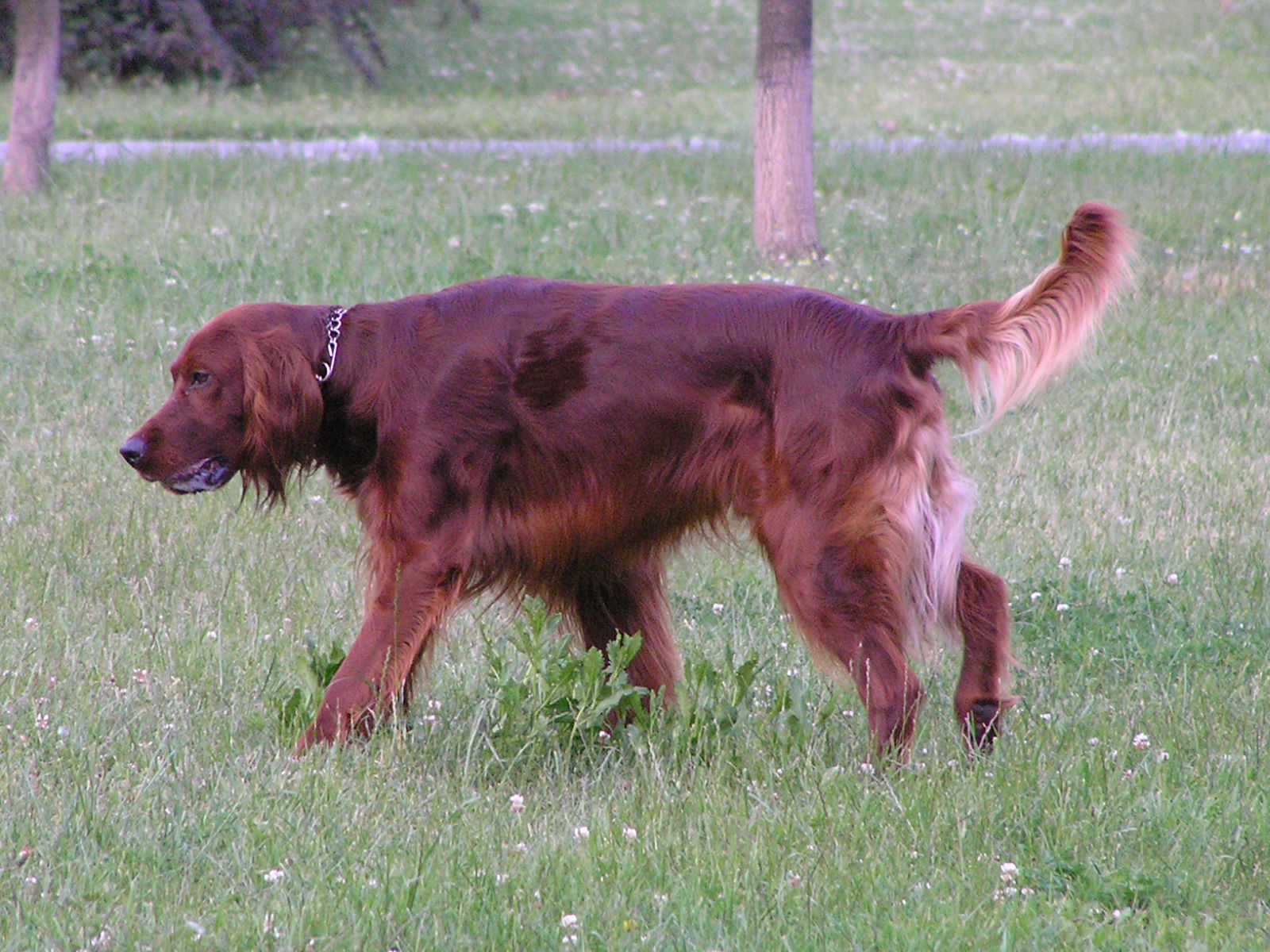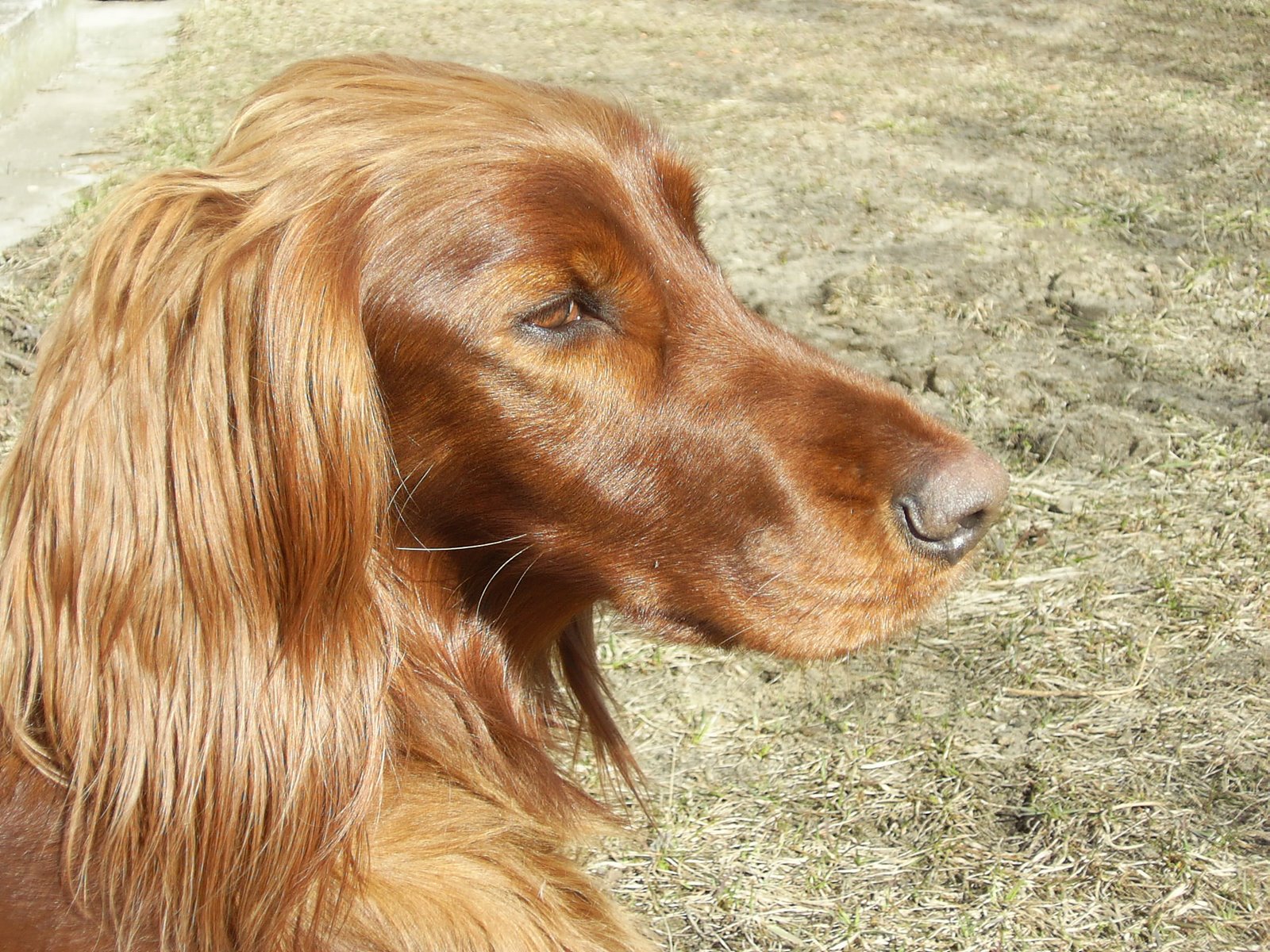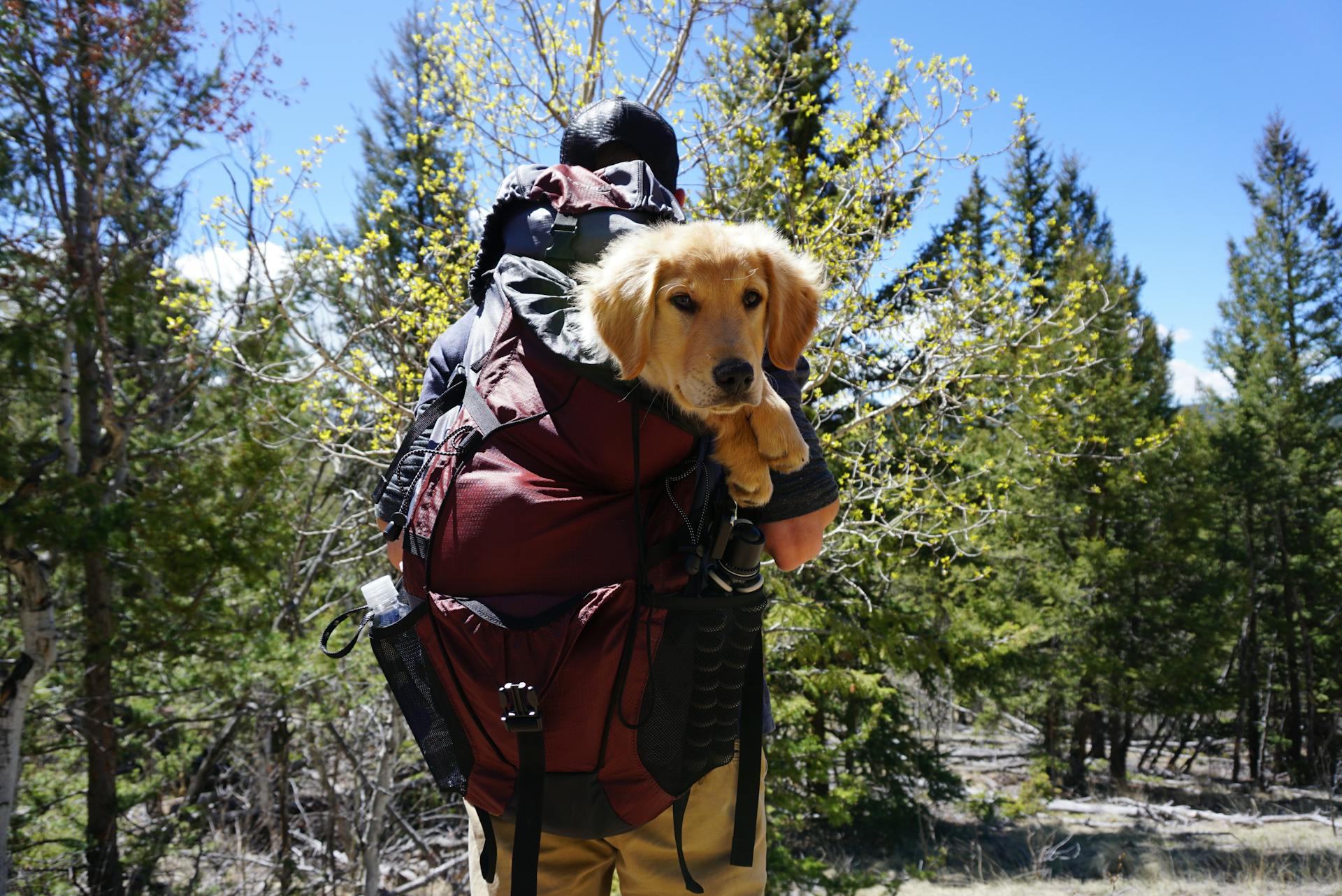
The Irish Setter dog breed has a rich history that dates back to the 18th century in Ireland. They were initially bred as hunting dogs, specifically for flushing out game birds.
Their original purpose was to be a versatile hunting companion, and they excelled at this task due to their exceptional speed, agility, and strong nose. The Irish Setter's ancestors were the Red Setter and the Black and Tan Setter.
One of the key characteristics of the Irish Setter is their striking red coat, which requires regular grooming to prevent matting and tangling. They have a medium-length coat that sheds heavily, making them a high-maintenance breed in terms of grooming needs.
Breed Overview
The Irish Setter is a medium to large-sized breed, standing between 25 to 27 inches tall.
They typically weigh between 60 to 70 pounds, making them a sturdy companion for active families.
Their coat is medium in length, with feathering on their ears, chest, legs, and tail, giving them a beautiful and elegant appearance.
Irish Setters are known for their friendly and outgoing temperament, being affectionate, intelligent, athletic, gentle, and sweet-tempered.
Their lifespan is relatively long, ranging from 12 to 15 years, making them a long-term companion for many families.
You might like: What Dog Food Is Making Dogs Sick
Overview

The Irish Setter is a fun-loving breed that's full of energy and enthusiasm. They're known for their flame-colored hair and their love of being active.
These dogs were originally developed as bird dogs, and they retain that drive and energy to this day. They have a strong hunting instinct and love to go on new adventures, especially if they involve birds.
Irish Setters are not suited to every home, as they require a lot of exercise and attention. A minimum of an hour of exercise daily is a must, and they need a large fenced yard or acreage where they can run.
They're a great breed for active families who will include them in everything they do, but they can develop separation anxiety if left alone too much. They're also prone to becoming destructive if they don't get enough physical and mental stimulation.
Irish Setters come in two types: show and field dogs, with the main difference being their size and coat thickness. Both types meet the breed standard, but they have the same natural ability to be a gundog.
They excel at many activities beyond hunting, including obedience, rally, tracking, and agility competition. They also make great therapy dogs, visiting hospices, retirement homes, and children's hospitals to spread their warmth and love.
Broaden your view: How Much Exercise Do Labrador Retrievers Need
History of

The Irish Setter's history is a fascinating one. The breed originated in Ireland in the 18th century, developed from a combination of English Setters, spaniels, pointers, and Gordon Setters.
The first Irish Setters were known as red spaniels or modder rhu, which is Gaelic for "red dog." They often had white and red coats instead of the solid dark red we see today.
The breed's popularity soared in the 1960s and 1970s, thanks in part to the books and movie featuring an Irish Setter named Big Red.
The Irish Setter was first registered by the American Kennel Club in 1878, with a dog named Admiral being the first to bear the title.
By the 1960s, the breed had become a favorite in the show ring, with 760 Irish Setters becoming conformation champions between 1874 and 1948.
The breed's popularity was also boosted by the presence of Irish Setter King Timahoe at the White House during the Nixon administration.
Today, the Irish Setter ranks 68th among the 155 breeds and varieties recognized by the AKC.
Core Characteristics
The Irish Setter's distinctive mahogany coat is a defining characteristic of the breed.
Its silky, straight hair is a beautiful sight to behold. The coat is medium in length, with minimal curls or waves. Extra featherings of fur can be found around the chest, ears, stomach, tail, and the backs of its legs.
Irish Setters are large dogs, standing between 25 to 27 inches tall and weighing between 60 to 70 pounds.
Their long, powerful legs make them one of the swiftest and most agile dogs in the sporting group.
This breed has a light-boned body, making it quick and agile. Its finer head compared to other setters is another notable feature.
The Irish Setter is a high-energy breed that requires a lot of exercise, ideally getting in two hours or more each day, running and playing.
They thrive in larger homes with gardens or yards where they can run freely.
Irish Setters are very friendly dogs, known for their sweet-natured and playful personalities. They're also intelligent and very affectionate.
However, they can be a bit stubborn and may need patient training to behave well.
Exercise and Training
Irish Setters are highly intelligent and quick learners, making them a natural fit for dog sports like flyball, dock diving, and canine agility. They excel in obedience training and can even serve as therapy or service dogs.
Their attentive nature and calm demeanor are a result of their breeding to be companions, but this also means they can be prone to separation anxiety. They don't tolerate being alone for extended periods, so they're best suited for owners who spend most of their day at home.
To train an Irish Setter, you'll need to provide consistent and positive reinforcement from an early age, including socialization with people and animals of all ages and sizes. This will help mold their prey drive and prevent them from getting too excited around smaller pets.
Exercise Needs
Exercise is essential for a sporting dog's happiness and well-being. At least an hour of vigorous activity is needed each day.

A brisk walk, run, or endless retrieval of tennis balls is perfect for this breed. These activities will keep your dog engaged and happy.
Ideally, a fenced yard provides a safe space for your dog to roam and romp. However, it won't replace the need for a daily walk or run.
If this caught your attention, see: How Fast Can a German Shorthaired Pointer Run
Training
Training your Irish Setter requires a consistent and positive approach, especially from puppyhood. This involves socialization with people of all ages and animals large and small.
Their intelligence and quick learning ability make them a natural fit for various dog sports, including field trials, flyball, dock diving, canine agility, and obedience.
Irish Setters are prone to separation anxiety due to their strong human companionship nature, so they're not ideal for someone who spends most of their day outside the home.
Grooming and Care
Grooming your Irish Setter's gorgeous red coat is relatively low-maintenance, requiring only a couple of brushing sessions per week and an occasional bath.
Their coat sheds heavily in spring, so be prepared to ramp up your grooming during this time to remove loose hair and prevent fur balls from flying.
To keep their coat shiny and tangle-free, brush your Irish Setter at least every other day, paying special attention to areas with long, silky feathering like the ears and tail.
Check for burrs and other debris after every outdoor adventure, and wipe out their ears weekly to prevent ear infections.
Trim their nails once or twice a month if they don't wear them down naturally, and start getting them accustomed to nail trimming early on to make the process easier.
Begin handling your Irish Setter's paws frequently to help them get used to it, as dogs can be quite sensitive about their feet.
Regular grooming sessions can also help you spot potential health problems early, so be sure to check for sores, rashes, or signs of infection on their skin, in their ears, nose, mouth, and eyes, and on their feet.
With regular care and attention, your Irish Setter's coat will remain healthy and beautiful, and they'll be a joy to be around.
Readers also liked: Why Are Labrador Retrievers so Popular
Health and Nutrition
Irish Setters are known for their energetic nature, which requires regular exercise to maintain their physical and mental health. They need at least 30 minutes of exercise per day.
Their high energy levels also make them prone to overeating, which can lead to obesity and other health issues if not managed properly. They have a short, dense coat that requires minimal grooming.
A balanced diet that includes a mix of protein, fat, and complex carbohydrates is essential for their overall health and well-being.
Diet and Nutrition
To keep your Irish Setter in top shape, start by feeding them a protein-rich dog food formula. This breed thrives on high-quality fuel for field activities or daily romps in the dog park.
Work with your vet to determine the right amount of daily calories for your dog based on their activity levels and age. A general recommendation is 2 to 3 cups of high-quality dry food a day, divided into two meals.

Irish Setters can be prone to bloat, a life-threatening condition, so it's essential to monitor their eating pace. Using slow-feeder dog bowls or feeding smaller, more frequent meals can help prevent this issue.
Regular exercise is crucial to keep your dog at a healthy weight and prevent obesity. If you're unsure whether your dog is overweight, give them the eye test and the hands-on test.
Health
Irish Setters are generally a healthy breed, but like many others, they can be prone to certain health issues. Bloating is a major concern, as it can happen suddenly and cause the abdomen to swell.
This is particularly common in big, deep-chested dogs like Irish Setters. Gases in the stomach build up quickly, causing the abdomen to expand like a balloon, and can even cut off normal blood circulation to the heart.
If you notice your dog is experiencing bloating issues, such as a swollen abdomen, you need to take them to the vet immediately. Too much trapped gas can be deadly.

Irish Setters also need regular ear checks to prevent infections. If their ears have too much hair, air circulation gets blocked, making infections more likely.
Some other health problems that Irish Setters are known to have include:
- Hip dysplasia, which can lead to canine arthritis
- Epilepsy
- Hypothyroidism
- Atopy, or sensitivity to certain allergens
- Entropion, a condition where the eyelids turn in
- Osteosarcoma (bone cancer)
Adoption and Ownership
If you're considering bringing an Irish Setter into your family, it's essential to do your research and find a reputable breeder or rescue organization. Always check with local rescue groups first, such as the Irish Setter Club of America Rescue Organization or Save Our Setters Rescue.
When looking for a breeder, make sure to meet the puppy's parents and receive health certificates. The National Breed Club recommends that breeders provide Optigen Testing Results for Progressive Retinal Atrophy, OFA Certification of Hips, Eye Exam for CERF, and OFA Thyroid Panel for any litter of Irish Setter puppies.
If you're set on adopting an adult Irish Setter, consider reaching out to a reputable rescue organization or checking the American Kennel Club Breeder Listing for a breeder in your area. The Irish Setter Club of America Breeder Listing is also a great resource for finding a responsible breeder.
Here are some resources to get you started:
- Irish Setter Club of America Rescue Organization
- Save Our Setters Rescue
- Irish Setter Club of America Breeder Listing
- American Kennel Club Breeder Listing
Where to Adopt/Buy
If you're looking to bring an Irish Setter into your life, there are several options to consider. Checking with local rescue groups is a great place to start.
You can find reputable breeders through the Irish Setter Club of America Breeder Listing or the American Kennel Club Breeder Listing.
Reputable breeders are committed to breeding healthy, well-socialized puppies that will make great companions. They will screen their breeding stock for health problems, socialize their puppies from a young age, and provide you with lifetime support.
If you do decide to buy from a breeder, make sure to ask for health certifications, such as Optigen Testing Results for Progressive Retinal Atrophy and OFA Certification of Hips.
Here are some reputable organizations to consider:
- Irish Setter Club of America Rescue Organization
- Save Our Setters Rescue
- Irish Setter Club of America Breeder Listing
- American Kennel Club Breeder Listing
Rescue Groups
If you're considering adopting an Irish Setter, it's essential to think carefully about what owning one entails. Many people purchase Irish Setters without fully understanding their needs, which can lead to a less-than-ideal situation for both the dog and the owner.
There are many Irish Setters in need of adoption and fostering, which is why rescue groups play a crucial role in helping them find new homes. If you're not sure where to start, you can contact the national breed club or a local breed club for guidance.
Some notable Irish Setter rescue groups include the Irish Setter Club of America Rescue, NorCal Irish Setter Rescue, Inc., and the Irish Setter Club of Ohio Rescue. These organizations work tirelessly to match Irish Setters with suitable owners and provide support to both parties.
If you're interested in adopting an Irish Setter, be sure to research and reach out to local rescue groups.
A different take: American Kennel Club Lancashire Heeler
Pros and Cons of Irish Setter Dogs
Irish Setter dogs have a strong hunting instinct and require regular exercise to stay happy and healthy. They need at least 30 minutes of exercise per day, whether it's a run, a swim, or a playtime in the yard.
Their short coats require minimal grooming, but they do shed heavily twice a year. This can be a challenge for some owners, especially those with allergies.
Irish Setters are generally good with children, but they can be boisterous and rough at times. They're not the best fit for families with very young kids who can't handle their energetic playstyle.
Their intelligence and loyalty make them excellent family pets, but they can be wary of strangers and may require time to warm up to new people.
Quick Facts and Overview
Irish Setters originated in Ireland as a gundog breed, bred to hunt birds. They're now popular companions, known for their friendly and outgoing personalities.
These large dogs typically stand 25-27 inches tall and weigh 60-70 pounds. Their long, silky coats require daily brushing to prevent matting.
Irish Setters are generally healthy dogs, but they can be prone to elbow and hip dysplasia, eye problems, and cancer. They live for 12-15 years on average.
Here are some key exercise needs for Irish Setters:
- At least 30-60 minutes of exercise per day
- Enjoy playing fetch, going for walks, and running around in the yard
Their intelligence and eagerness to please make them easy to train with positive reinforcement. Irish Setters are playful and affectionate dogs that love to be around people.
History of Setters
The Irish Setter breed has a rich history that dates back to the 18th century, when English Setters, spaniels, pointers, and Gordon Setters were combined to create the first Irish Setters.
These early dogs were often called red spaniels or modder rhu, which is Gaelic for "red dog." They had a variety of coat patterns, including white and red, and some even had small white spots.
The Irish Earl of Enniskillen was a big fan of solid red dogs and only had them in his kennels by 1812. Other breeders, like Jason Hazzard and Sir St. George Gore, also preferred the solid red coat.
The first Irish Setter imported to the United States was a dog named Elcho, who arrived in 1875 and became a star in both the show ring and the field.
Quick Facts

Irish Setters are a gundog breed that originated in Ireland, originally bred to hunt birds. Some Irish Setters continue hunting today.
They are large dogs, typically standing 25-27 inches tall at the shoulder and weighing 60-70 pounds. Their long, silky coats and feathered ears make them a distinctive breed.
Irish Setters live 12-15 years, which is a relatively long lifespan for a dog. Unfortunately, they can be prone to health problems like elbow and hip dysplasia, eye problems, and cancer.
Their coat is long, silky, and flowing, and while they can be any color, the most common colors are red, mahogany, and chestnut. Brushing their coat daily can help prevent matting.
Irish Setters are friendly, outgoing, and intelligent dogs that are playful and affectionate. They love to be around people and make great family pets.
Here are some key characteristics of the Irish Setter breed:
Irish Setters need at least 30-60 minutes of exercise per day, which can include playing fetch, going for walks, and running around in the yard. They're eager to please and respond well to positive reinforcement training.
Originally Known as

The Irish Setter was originally known as the Irish Red Setter in the U.S. to distinguish from the ones in Ireland that were red and white.
Size and Personality
Irish Setters are outgoing and love people, making them perfect companions for families and individuals alike. They're not really guard dogs, but they'll step in to protect their people when needed.
Their playful and mischievous nature means they can get into all sorts of trouble, like raiding your underwear drawer and prancing around with a leopard-print thong in their teeth. This is just a sign of their fun-loving personality and love of a good time.
Irish Setters are slow to mature, so they'll retain their puppy enthusiasm for several years and often throughout their life. This means they'll always be ready for a rollicking good time, whether it's a romp in the park or a lazy afternoon at home.
Explore further: Best Time to Breed a Dog
Size
When it comes to size, Irish Setters are a medium to large breed. The typical male Irish Setter stands 27 inches at the shoulder and weighs 70 pounds.
Females, on the other hand, are slightly smaller, standing at 25 inches tall and weighing 60 pounds.
Their size can vary, but overall, Irish Setters are a sturdy breed that requires regular exercise to stay healthy.
Personality

The Irish Setter is a fun-loving, playful, and affectionate breed, always ready for a good time. They're outgoing and love people, but not exactly guard dogs - they'll protect their family if needed, though.
Irish Setters are slow to mature and retain their puppy enthusiasm for several years, often throughout their lives. This means they'll stay energetic and playful well into adulthood.
As a breed, Irish Setters are excellent watchdogs and will bark to alert their family to visitors or intruders. They're naturally alert and will sound the alarm if they sense something's off.
Irish Setters need early socialization to become well-rounded dogs. This means exposing them to many different people, sights, sounds, and experiences when they're young.
Recommended read: Shiba Inu One Cent
Special Considerations
Irish Setters are known for being very affectionate and loving, so be prepared for a lifelong companion that will shower you with attention and affection.
They love to play, especially fetch, and will keep you on your toes with their energetic and playful nature.
Worth a look: Can Shiba Inu Hit 1 Cent
However, their high energy levels can sometimes get the best of them, especially as puppies, so make sure to supervise interactions with small children.
Irish Setters aren't guard dogs, they welcome everyone with open arms and aren't aggressive at all.
They're alert and intuitive, which makes them great with most people and pets, but remember to socialize them well to ensure they get along with everyone.
Irish Setters mature slowly, both mentally and physically, so be patient and give them time to grow and learn.
They're intelligent and want to learn, but can be stubborn at times, so be loving and firm with positive reinforcement training.
Once they learn a lesson, they don't forget it, so make sure to reinforce good behavior consistently.
Hunting and Retrieving
Irish Setters are natural-born hunters with a strong instinct to point and retrieve game. They've been popular for hunting since the 18th century.
Their talent for retrieving is unmatched, and most Irish Setters do it naturally. They're a superb bird dog, with a strong nose and enthusiasm for the task at hand.
A unique perspective: Strongest Dog Names
In fact, Colonel Millner, a British breeder, said that Irish Setters make excellent retrievers on land and from water, and this still holds true today. They're natural retrievers, and with proper training, they'll do no harm.
Many hunters, including those in the UK, Canada, New Zealand, America, and Norway, have noted the breed's innate love for retrieving. They're well-suited for field trials, duck hunting, and other waterfowl activities.
One breeder, Robyn Gaskin, noted that her Irish Setters are natural retrievers and make fine duck dogs. They're a bit more versatile than other breeds, like English Setters, and have a strong drive for waterfowl.
With consistent training and socialization, Irish Setters can excel in various activities, including flyball, dock diving, and canine agility. They're intelligent and quick learners, making them a joy to train.
However, Irish Setters do have a tendency to get separation anxiety, so they're not ideal for owners who spend most of their day away from home.
Intriguing read: Dogo Argentino Natural Ears
Frequently Asked Questions
Do Irish Setters bark a lot?
Irish Setters are generally quiet dogs, but they will alert you with a bark when they sense something unusual. They're not excessive barkers, but rather alert barkers.
Do Irish Setter dogs shed?
Irish Setters shed moderately, with most shedding occurring during spring and autumn. They are not a hypoallergenic breed, making them less suitable for families with allergy concerns.
Can Irish Setters be aggressive?
Irish Setters are generally alert and not prone to aggression. However, socialization and proper training are key to ensuring their friendly nature.
Sources
- https://www.thesprucepets.com/irish-setter-dog-breed-profile-4775999
- https://dogtime.com/dog-breeds/irish-setter
- https://www.webmd.com/pets/dogs/what-to-know-about-irish-setters
- https://www.akc.org/expert-advice/lifestyle/fun-facts-about-the-irish-setter/
- https://projectupland.com/hunting-dogs/irish-setter-breed-profile/
Featured Images: pexels.com


